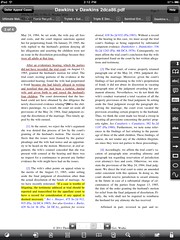The New Rule 9.420 — Time and Service
Coming on the heels of mandatory e-mail service, the Florida Supreme Court has revised the rules for calculation of time, to be uniform across all of the rules. See SC10-2299 (July 12, 2012) [.pdf]. As with e-mail service, the new time calculation rules are found in the Florida Rules of Judicial Administration — Florida Rule of Judicial Administration 2.514 (Computing and Extending Time) will be your your new best friend come October 1, 2012.
New Rule 2.514 models itself somewhat after the Federal Rules’ addition of direction for calculating time periods stated in days or hours. However, it does not go so far as to entirely adopt a “days are days” philosophy:
When the period stated in days is less than 7 days, intermediate Saturdays, Sundays and legal holidays shall be excluded in the computation.
Fla. R. Jud. Admin. Rule 2.514(a)(3)(effective Oct. 1, 2012). No doubt, this is to avoid having to go through the legislature to amend statutory calculations that were based on the old rule.
It is now official that the last day ends at midnight, at least for electronic filing and any service, which as always is a blessing and a curse for lawyers everywhere. Rule 2.514(4)(A). If filing is being done by other means (i.e., in person) the last day ends remains when the clerk’s office closes (and remember, clerk’s offices are closing earlier due to budget constraints, so be careful!). Rule 2.514(4)(B).
The new rule also clarifies what constitutes a legal holiday — before, what constituted a holiday varied between the civil rules and the appellate rules. A legal holiday is now
(A) the day set aside by section 110.117, Florida Statutes, for observing New Year’s Day, Martin Luther King Jr.’s Birthday, Memorial Day, Independence Day, Labor Day, Veterans’ Day, Thanksgiving Day, the Friday after Thanksgiving Day, or Christmas Day; and
(B) any day observed as a holiday by the clerk’s office or as designated by the chief judge.
Interestingly, former case law often looked to Section 683.01, Florida Statutes, entitled “Legal Holidays”, to determine what constituted a holiday. See, e.g., Flack v. Carter, 392 So. 2d 37, 39 (Fla. 1st DCA 1980)(looking to 683.01 to determine whether electoral protest was timely filed); Turner v. State, 382 So. 2d 780, 782 (Fla. 4th DCA 1980)(legal holiday under criminal rules of procedure as defined in 683.01); Azalea Homes v. Makela, 77 So. 2d 451, 452 (Fla. 1955)(refusing to apply Section 683.01 to deem petition filed on Tuesday July 6 to be timely where it was due Monday July 5 but Sunday July 4 was the legal holiday). All of these cases are likely superseded by new Rule 2.514. One would hope that there will be less need for litigation over calculation issues with the new rule.
Finally, lawyers still get to keep their precious mailing days, even when there is service by e-mail. New Rule 2.514(b) reads:
(b) Additional Time after Service by Mail or E-mail. When a party may or must
act within a specified time after service and service is made by mail or e-mail, 5 days are added after the period that would otherwise expire under subdivision (a).
Fla. R. Jud. Admin. 2.514(b) (effective Oct. 1, 2012).
Coupled with the changes to the service rule, As of October 1, 2012 Fla. R. App. P. 9.420 will be an almost entirely different creature. I’ve inserted a copy of the two new Rules of Judicial Administration right after Rule 9.420 in my .pdf of the appellate rules, so that I don’t need to flip back and forth between files on my iPad when the issue comes up. Be sure to alert staff to these important changes.

